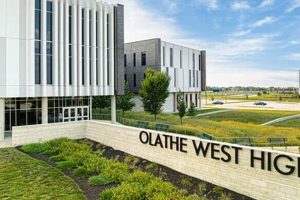Combined baccalaureate-M.D. programs offer students an accelerated pathway to a medical career, integrating undergraduate and medical school curricula into a single, cohesive six-year track. These programs typically involve a rigorous science-focused curriculum during the initial pre-professional phase, followed by a transition into the traditional medical school components of clinical rotations and specialized studies. Admission is highly competitive, often requiring exceptional academic performance in high school and demonstrated interest in medicine through extracurricular activities and volunteer experience.
Such streamlined pathways offer several potential advantages. The condensed timeframe can represent significant cost savings compared to completing a separate undergraduate degree and then applying to medical school. Additionally, the integrated curriculum often fosters a more focused and in-depth understanding of medical sciences from an earlier stage. This approach also allows students to enter the medical profession sooner, contributing to the workforce more rapidly. The historical context of these programs reflects a broader trend in higher education toward more efficient and targeted educational pathways.
The subsequent sections will delve into specific aspects of combined degree medical programs, including admissions requirements, curriculum details, career prospects, and prominent institutions offering these opportunities. Further exploration will cover potential challenges and considerations for prospective applicants navigating this unique academic pathway.
Tips for Applying to Accelerated Medical Programs
Navigating the application process for combined baccalaureate-M.D. programs requires careful planning and strategic preparation. The following tips offer guidance for prospective applicants.
Tip 1: Early and Extensive Academic Preparation: A strong high school record, particularly in science and mathematics, is crucial. Advanced Placement or International Baccalaureate courses demonstrate rigorous academic engagement.
Tip 2: Demonstrate a Genuine Interest in Medicine: Meaningful extracurricular activities, such as volunteering in healthcare settings, shadowing physicians, or participating in medically-related clubs, provide valuable experience and showcase commitment.
Tip 3: Research Program-Specific Requirements: Each institution has unique prerequisites and admissions criteria. Thorough research into specific program requirements is essential for a competitive application.
Tip 4: Craft Compelling Application Materials: A well-written personal essay that articulates a clear motivation for pursuing medicine and highlights relevant experiences is paramount. Strong letters of recommendation from teachers and mentors who can attest to academic capabilities and character are also essential.
Tip 5: Prepare Thoroughly for Interviews: Practice articulating responses to common interview questions, demonstrating a thorough understanding of the medical profession and a genuine passion for patient care.
Tip 6: Explore Multiple Program Options: Applying to several programs increases the chances of acceptance. Consider geographical preferences, program curricula, and institutional culture when selecting programs.
Tip 7: Manage Time Effectively: Balancing rigorous academic demands with extracurricular commitments and application requirements necessitates strong time management skills.
By focusing on these key areas, applicants can strengthen their candidacy and increase their likelihood of acceptance into a combined baccalaureate-M.D. program. These preparatory steps contribute to a well-rounded application that reflects academic excellence, a genuine passion for medicine, and a commitment to the rigorous demands of an accelerated medical pathway.
In conclusion, these combined programs offer a unique opportunity for dedicated students to embark on an accelerated path toward a fulfilling medical career. The insights and guidance provided throughout this article aim to empower prospective applicants with the knowledge and tools necessary to successfully navigate the application process and pursue their aspirations in medicine.
1. Accelerated Curriculum
The accelerated curriculum inherent in combined baccalaureate-M.D. programs distinguishes these pathways from traditional pre-med and medical school tracks. This condensed timeframe requires a rigorous and highly structured approach to learning, impacting various facets of the educational experience.
- Compressed Timeline:
The most prominent feature is the compression of undergraduate and medical coursework into six years. Traditional pathways typically require four years of undergraduate study followed by four years of medical school. This two-year reduction necessitates a faster pace of learning and efficient integration of pre-medical and medical sciences.
- Integrated Coursework:
Accelerated programs often feature a seamless transition between pre-clinical and clinical studies. Basic sciences, typically covered during undergraduate years, are integrated with medical school coursework, facilitating a more cohesive and contextually relevant learning experience. For example, a student might study organic chemistry alongside its direct applications in pharmacology.
- Increased Academic Rigor:
The condensed timeframe requires students to handle a higher volume of material at an accelerated pace. This increased academic rigor demands strong time management skills, effective study habits, and a high level of self-discipline. The ability to absorb and synthesize information efficiently is crucial for success.
- Earlier Clinical Exposure:
Many accelerated programs offer earlier exposure to clinical settings, allowing students to apply theoretical knowledge in practical scenarios sooner. This earlier immersion in clinical practice can reinforce learning and provide a clearer understanding of the realities of a medical career. It also offers valuable opportunities for mentorship and professional development.
These interconnected facets of the accelerated curriculum contribute to the unique nature of combined baccalaureate-M.D. programs. The compressed timeline, integrated coursework, increased academic rigor, and earlier clinical exposure combine to create a demanding yet potentially rewarding pathway for motivated students seeking an efficient and immersive route to a medical career. While challenging, this approach offers a focused and streamlined educational experience, ultimately leading to earlier entry into the medical profession.
2. Integrated Coursework
Integrated coursework represents a defining characteristic of 6-year medical programs, distinguishing them from traditional pre-medical pathways. This pedagogical approach weaves together undergraduate and medical school curricula, fostering a cohesive and interconnected learning experience that accelerates the acquisition of medical knowledge and skills. This integration streamlines the educational journey, allowing students to delve into medically relevant content earlier and fostering a deeper understanding of the interconnectedness of various scientific disciplines.
- Early Introduction to Medical Sciences:
Traditional pre-med curricula often postpone in-depth medical science exposure until the later years of undergraduate study. Integrated programs introduce core medical sciences, such as anatomy, physiology, and biochemistry, earlier in the curriculum, often during the first two years. This early exposure provides a foundation for subsequent learning and allows students to approach undergraduate coursework with a clearer understanding of its relevance to their future medical careers. For instance, students might explore the biochemical basis of disease processes concurrently with their organic chemistry coursework, solidifying their understanding of both subjects.
- Bridging Basic Sciences and Clinical Applications:
Integrated coursework emphasizes the connections between basic sciences and their clinical applications. Rather than treating these as separate disciplines, the curriculum bridges the gap, demonstrating how fundamental scientific principles directly inform medical practice. This approach can enhance understanding and retention of complex concepts. For example, studying the physiology of the cardiovascular system might be directly linked to learning about common cardiac conditions and their treatments.
- Streamlined Progression to Clinical Experiences:
The integrated nature of the curriculum facilitates a smoother transition into clinical rotations. By establishing a solid foundation in medical sciences during the pre-clinical years, students can engage more effectively with practical experiences in clinical settings. This earlier and more informed exposure to patient care can strengthen clinical skills and provide a more comprehensive understanding of the medical profession. Shadowing experiences, for instance, can be integrated with relevant coursework, enriching the learning process and solidifying career aspirations.
- Emphasis on Interdisciplinary Connections:
Integrated coursework often emphasizes the interconnectedness of various scientific disciplines relevant to medicine. This interdisciplinary approach fosters a holistic understanding of the human body and disease processes, recognizing that medical practice requires knowledge from multiple fields. For example, a course might integrate concepts from biology, chemistry, physics, and even social sciences to explore a particular health issue from multiple perspectives, demonstrating the interconnectedness of these disciplines.
By fostering these interconnections, integrated coursework in 6-year medical programs creates a more cohesive and efficient learning experience. This approach not only accelerates the acquisition of medical knowledge but also cultivates a deeper understanding of the interdisciplinary nature of medicine, preparing students for the complexities and challenges of a medical career. The seamless blend of theoretical knowledge and practical application creates a well-rounded foundation for future physicians, enabling them to enter the profession with a more comprehensive and integrated understanding of medical science and practice.
3. Early Career Entry
Early career entry represents a significant advantage of 6-year medical programs commencing directly after high school. By condensing the traditional undergraduate and medical school timeline, these programs enable graduates to enter the medical profession approximately two years earlier than their counterparts pursuing separate undergraduate degrees. This accelerated trajectory offers numerous potential benefits, both personal and professional, while also presenting certain considerations.
The primary benefit of early career entry is a reduced opportunity cost. Students forgo two years of potential earnings, allowing them to begin contributing to the healthcare workforce and earning a physician’s salary sooner. This earlier financial independence can be particularly attractive for students seeking to minimize educational debt or support their families. Additionally, accelerated programs often offer a more focused educational experience, potentially reducing the overall cost of education compared to pursuing separate undergraduate and medical degrees. However, it’s important to note that tuition costs for these programs can still be substantial and require careful financial planning. For example, students might explore scholarship opportunities or consider the long-term financial benefits of earlier career entry when evaluating the overall cost of education.
Beyond financial advantages, early career entry allows individuals to contribute to the medical field sooner, addressing potential physician shortages and fulfilling a desire to serve others more quickly. This earlier entry can also provide a head start in career advancement, allowing graduates to gain experience and progress towards specialization or leadership roles earlier in their professional lives. For instance, a graduate of a 6-year program might begin a specialized residency two years earlier than a traditional medical school graduate, potentially reaching sub-specialization or leadership positions sooner. However, it’s important to consider the potential impact of a condensed pre-medical education. While accelerated programs ensure comprehensive medical training, the shortened timeframe might limit opportunities for broader academic exploration or the development of non-medical skills that could contribute to a well-rounded professional profile. Therefore, prospective students should carefully weigh the benefits of early career entry against the potential limitations of a condensed pre-medical experience, considering their individual career goals and learning preferences.
In summary, early career entry is a compelling aspect of 6-year medical programs. The financial and professional advantages, including reduced opportunity cost and earlier contributions to the medical field, are significant. However, prospective students should carefully evaluate the overall cost of education and consider the potential trade-offs associated with a condensed pre-medical curriculum. A thorough understanding of these factors allows individuals to make informed decisions aligned with their long-term career aspirations and personal values. Ultimately, the choice between an accelerated program and a traditional pathway depends on individual circumstances, priorities, and a realistic assessment of the demands and opportunities associated with each option.
4. Rigorous Academics
Rigorous academics form the cornerstone of combined baccalaureate-M.D. programs, representing a defining characteristic that sets these accelerated pathways apart. The condensed timeframe necessitates a demanding academic environment, requiring students to assimilate a substantial volume of information at an accelerated pace. This academic intensity serves several critical purposes, shaping the educational experience and preparing students for the demanding realities of a medical career. The inherent rigor cultivates essential skills, including critical thinking, problem-solving, and efficient information synthesis, all crucial for success in medical school and beyond. For instance, students might encounter complex case studies requiring them to integrate knowledge from multiple disciplines to arrive at a diagnosis or treatment plan. This constant intellectual engagement fosters adaptability and resilience, essential qualities for navigating the ever-evolving landscape of medical science and practice. The demanding curriculum also instills a strong work ethic and time management skills, essential for balancing the heavy workload of medical school and the subsequent demands of residency and medical practice.
The high academic standards of these programs contribute significantly to the quality of graduates. The rigorous curriculum ensures a comprehensive understanding of foundational medical sciences, preparing students for the intellectual challenges of medical school and beyond. Furthermore, the demanding nature of the program serves as a filter, selecting for students with exceptional academic aptitude, dedication, and resilience. This self-selection process contributes to a highly motivated and academically capable cohort, fostering a collaborative and intellectually stimulating learning environment. For example, students might participate in research projects alongside faculty, contributing to advancements in medical knowledge while honing their critical thinking and analytical skills. This combination of rigorous coursework and research opportunities prepares graduates to excel in medical school, residency, and ultimately, as practicing physicians.
In conclusion, rigorous academics are not merely a feature of combined baccalaureate-M.D. programs; they are an integral component of their success. This demanding academic environment cultivates essential skills, ensures a high caliber of graduates, and prepares students for the intellectual rigors of a medical career. While challenging, the academic intensity of these programs ultimately contributes to the development of competent, adaptable, and resilient physicians equipped to navigate the complexities of modern healthcare. The challenges presented by rigorous academics ultimately contribute to the overall quality and preparedness of graduates entering the medical profession. Understanding the inextricable link between academic rigor and success in these accelerated programs is crucial for prospective applicants considering this demanding yet rewarding pathway to a medical career.
5. Competitive Admissions
Competitive admissions represent a defining characteristic of 6-year medical programs commencing directly after high school. The limited number of available slots in these prestigious programs, coupled with the significant advantages they offer, creates a highly selective admissions process. Understanding the competitive landscape is crucial for prospective applicants seeking to navigate this challenging yet rewarding pathway to a medical career. The high demand for these programs stems from several factors, including the guaranteed pathway to medical school, the condensed timeframe for completing both undergraduate and medical education, and the potential for significant cost savings compared to pursuing separate degrees. This combination of benefits attracts a large pool of highly qualified applicants, making admission extremely competitive.
- Exceptional Academic Performance:
A stellar high school transcript, particularly in science and mathematics courses, is a fundamental requirement. High GPAs, rigorous coursework (such as Advanced Placement or International Baccalaureate classes), and standardized test scores (like the SAT or ACT) play a crucial role in demonstrating academic aptitude. For example, successful applicants often present near-perfect GPAs and high standardized test scores, reflecting a consistent commitment to academic excellence.
- Demonstrated Commitment to Medicine:
Admissions committees seek evidence of a genuine and sustained interest in medicine beyond academic achievements. Meaningful extracurricular activities, such as volunteering in healthcare settings, shadowing physicians, participating in medically related clubs, or conducting research, demonstrate a commitment to the field and provide valuable experience. For instance, a student who has volunteered extensively in a hospital emergency room or shadowed a physician specializing in a field of interest demonstrates a proactive engagement with the medical profession.
- Strong Communication and Interpersonal Skills:
Effective communication and interpersonal skills are essential for success in medicine. Admissions committees assess these qualities through application essays, letters of recommendation, and interviews. Applicants must articulate their motivations for pursuing medicine clearly and compellingly, demonstrating empathy, maturity, and a genuine desire to serve others. A well-crafted essay that conveys personal experiences and insights into the medical profession, coupled with strong letters of recommendation highlighting interpersonal skills and character, can significantly strengthen an application.
- Well-Rounded Profile:
While academic excellence and a demonstrated interest in medicine are paramount, a well-rounded profile showcasing diverse interests and experiences can also contribute to a competitive application. Participation in extracurricular activities outside of medicine, such as music, athletics, or community service, demonstrates a breadth of experience and personal development, highlighting qualities like leadership, teamwork, and time management. For instance, a student who captained a sports team while maintaining high academic performance and volunteering in a medical setting showcases a well-rounded profile with strong leadership and organizational skills.
These interconnected factors contribute to the highly competitive nature of admissions to 6-year medical programs. The selective process ensures that admitted students possess the academic aptitude, commitment, and personal qualities necessary to thrive in a demanding accelerated medical curriculum. Prospective applicants must recognize the importance of meticulous preparation and strategic planning to navigate this competitive landscape successfully. By demonstrating a combination of exceptional academic achievement, a genuine passion for medicine, strong communication skills, and a well-rounded profile, applicants can enhance their candidacy and increase their likelihood of acceptance into these prestigious programs. Ultimately, the competitive admissions process serves to identify and select individuals with the potential to excel in an accelerated medical pathway and become successful and compassionate physicians.
6. Commitment Required
An unwavering commitment represents a cornerstone of success within demanding 6-year medical programs starting directly after high school. These accelerated pathways present unique challenges stemming from the condensed timeframe and rigorous curriculum, necessitating a level of dedication exceeding that of traditional undergraduate experiences. This commitment encompasses multiple facets, extending beyond academic diligence to include emotional resilience, personal sacrifice, and a sustained passion for medicine. The intensive nature of these programs demands consistent effort, often requiring students to forgo certain social activities, hobbies, or personal pursuits to maintain academic performance and meet program requirements. For instance, balancing the demands of a rigorous medical curriculum with extracurricular activities or part-time employment requires exceptional time management skills and prioritization, often necessitating difficult choices and trade-offs. Maintaining a healthy work-life balance, while challenging, remains crucial for preventing burnout and sustaining long-term commitment.
The substantial commitment required manifests in various ways. Academically, students face a heavy workload, requiring extensive study hours, meticulous preparation for examinations, and active participation in challenging coursework. This academic intensity necessitates strong study habits, effective time management strategies, and a proactive approach to learning. Beyond academics, students must cultivate emotional resilience to navigate the pressures of a demanding program, cope with setbacks, and maintain motivation throughout the six-year journey. The ability to adapt to new learning environments, handle constructive criticism, and learn from mistakes are essential attributes for success. For example, students might face challenging clinical rotations requiring them to adapt quickly to new environments, work effectively under pressure, and manage emotionally demanding situations. Developing strong interpersonal skills, empathy, and professionalism are crucial for navigating these experiences effectively and maintaining a positive learning trajectory.
In summary, undertaking a 6-year medical program directly after high school represents a significant commitment demanding dedication, resilience, and a genuine passion for medicine. The condensed timeframe and rigorous curriculum necessitate sacrifices, strong organizational skills, and an unwavering focus on long-term goals. Recognizing the multifaceted nature of this commitment, prospective applicants must engage in thorough self-assessment to determine their readiness for this demanding yet rewarding pathway. A realistic understanding of the required commitment is crucial for making informed decisions and ensuring long-term success within these accelerated medical programs. Ultimately, this level of dedication serves as a crucial filter, selecting individuals with the necessary drive and perseverance to excel in a demanding medical environment and contribute meaningfully to the healthcare profession. Recognizing this connection allows prospective students to make informed decisions and embark on this challenging pathway with a realistic understanding of the required dedication and perseverance.
7. Cost Considerations
Cost considerations represent a significant factor in evaluating combined baccalaureate-M.D. programs. While these accelerated pathways may offer potential long-term cost benefits compared to pursuing separate undergraduate and medical degrees, substantial financial investment remains necessary. Tuition, fees, and living expenses accumulate over six years, requiring careful planning and resource assessment. The direct costs, including tuition and fees specific to the combined program, often differ from the combined costs of a separate four-year undergraduate degree and subsequent medical school application fees and tuition. Indirect costs, such as housing, meals, transportation, and books, also contribute significantly to the overall financial burden. For example, attending a program located in a major metropolitan area can significantly increase living expenses compared to a program situated in a smaller city or town. Furthermore, the opportunity cost of forgone earnings during the six-year program should be considered. While graduates enter the workforce earlier than those pursuing traditional pathways, they forego potential income during the undergraduate years, impacting overall financial planning.
Potential cost-saving mechanisms exist for mitigating the financial burden. Merit-based scholarships, need-based financial aid, and external loan programs specifically designed for medical students can provide valuable financial assistance. Early planning and diligent exploration of funding opportunities are crucial for minimizing debt accumulation. For instance, seeking scholarships targeted towards students in accelerated medical programs or exploring loan forgiveness programs for physicians practicing in underserved communities can significantly impact long-term financial outcomes. Additionally, some institutions offer integrated programs with reduced tuition rates compared to their separate undergraduate and medical school counterparts, creating potential cost advantages. Comparing the total cost of various programs, including tuition, fees, and estimated living expenses, facilitates informed decision-making and allows prospective applicants to assess the long-term financial implications of each option.
In summary, cost considerations play a vital role in evaluating combined baccalaureate-M.D. programs. While these programs may offer potential long-term financial benefits, substantial upfront investment requires careful planning and resource management. Exploring potential cost-saving mechanisms, such as scholarships, grants, and loan programs, proves essential for minimizing financial burden and making informed decisions. A comprehensive understanding of both direct and indirect costs empowers prospective applicants to navigate the financial complexities of these accelerated medical pathways and choose the option best aligned with individual circumstances and long-term financial goals. This proactive approach to financial planning can significantly impact long-term financial well-being and allow graduates to focus on their medical careers without excessive financial strain. Understanding the complex interplay of cost considerations and potential long-term financial benefits is essential for making informed decisions about this unique pathway to a medical career.
Frequently Asked Questions
This section addresses common inquiries regarding combined baccalaureate-M.D. programs, offering concise and informative responses to facilitate informed decision-making for prospective applicants.
Question 1: How do these programs differ from traditional pre-med pathways?
These programs integrate undergraduate and medical education into a single six-year curriculum, eliminating the need for separate undergraduate degree completion and medical school application. Traditional pathways involve four years of undergraduate study followed by application to and completion of a four-year medical school program.
Question 2: What are the typical admission requirements?
Admission requirements typically include a strong high school academic record, particularly in science and mathematics, demonstrated interest in medicine through extracurricular activities or volunteer experiences, competitive standardized test scores (SAT or ACT), and strong letters of recommendation. Specific requirements vary by institution.
Question 3: Is the workload significantly more demanding than a traditional undergraduate program?
The accelerated nature of these programs necessitates a rigorous and demanding curriculum. The workload is generally considered more intensive than a traditional undergraduate program due to the compressed timeframe and the volume of material covered.
Question 4: What are the advantages of completing such a program?
Advantages include earlier entry into the medical profession, potential cost savings compared to separate undergraduate and medical degrees, a focused and integrated curriculum, and early exposure to clinical settings.
Question 5: Are there any disadvantages to consider?
Disadvantages may include a highly demanding workload, limited opportunities for exploration outside of medicine during undergraduate years, and the commitment required for a six-year accelerated program. Careful consideration of personal learning preferences and career goals is advised.
Question 6: What career options are available after graduation?
Graduates are eligible to pursue residency programs in their chosen medical specialties, leading to licensure and practice as physicians. Career options span a wide range of medical specialties, including primary care, surgery, and various subspecialties.
Careful consideration of these frequently asked questions, combined with thorough research and self-assessment, will assist prospective applicants in making informed decisions regarding this unique pathway to a medical career. Understanding the advantages, disadvantages, and specific requirements of these programs is crucial for navigating the application process and succeeding in a demanding yet rewarding medical education.
For further information on specific program offerings, admissions requirements, and curriculum details, consult individual institutional websites and contact admissions offices directly.
Six-Year Medical Programs Out of High School
Combined baccalaureate-M.D. programs offer a unique and demanding pathway for students aspiring to a medical career. This exploration has highlighted key aspects of these accelerated programs, including the rigorous academics, competitive admissions process, required commitment, cost considerations, and the benefits of integrated coursework and early career entry. The potential advantages of a streamlined path to medicine are significant, yet require careful consideration of the inherent challenges and personal suitability for this accelerated trajectory. Potential applicants must assess their academic preparedness, commitment to medicine, and financial capacity to undertake this intensive educational journey.
The future of healthcare relies on a dedicated and well-trained physician workforce. Six-year medical programs represent one pathway toward fulfilling this need, offering a unique opportunity for driven and focused individuals to enter the medical profession prepared to contribute meaningfully to patient care and medical advancement. Thorough research and self-assessment remain crucial for prospective applicants contemplating this demanding yet rewarding path. The decision to pursue such a program represents a significant commitment requiring careful consideration of individual circumstances, aspirations, and the long-term implications of an accelerated medical education.







